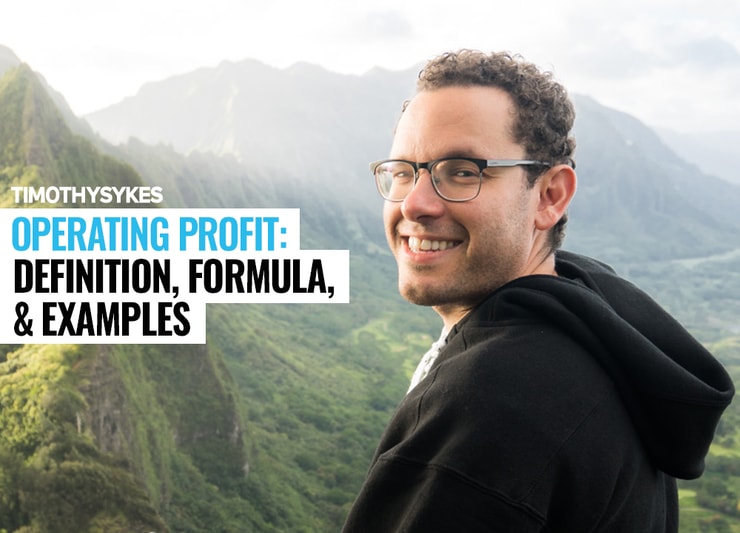A lot of traders zone out when they hear terms like ‘operating profit.’
After all, that’s an accounting term, right? What does that have to do with a hot stock pick? If that’s your mentality, you’ve got a problem.
One of the biggest reasons many traders fail is because they don’t take the time to learn how the financial markets and stocks actually work.
You’ve got to learn all you can. Your education never really ends. There’s always something new to learn. And knowledge is power when it comes to trading.
Yes, I put a lot of emphasis on technical analysis. I look at charts and price action.
But if you’re trying to make a case for whether a trade is a good idea, you need to consider as many variables as you can.
Yeah, that means digging deeper with your stock research. You need to look at the ‘boring’ fundamentals. Things like operating profit can help you better understand a company’s potential profitability.
Again, it all boils down to making smarter trading decisions.
So what is operating profit, why does it matter, and how specifically can it help you make smarter trades? I’ll explain it all here. Plus I’ll help you figure out how to fit it into your stock research.
Table of Contents
- 1 What Is Operating Profit? Here’s the Definition
- 2 How Does Operating Profit Work?
- 3 Example of Operating Profit
- 4 Why Does Operating Profit Matter?
- 5 What Is the Operating Profit Ratio?
- 6 How Do You Calculate Operating Profit?
- 7 Frequently Asked Questions About Operating Profit
- 8 Trading Challenge
- 9 The Final Word on Operating Profit
What Is Operating Profit? Here’s the Definition

2025 Millionaire Media, LLCWhat does operating profit mean?
Operating profit is an accounting term. It refers to the profits a company makes from its core business … but with a few adjustments.
This number includes a company’s profits but removes overhead and operating expenses.
It also removes income from non-core business-related sources from the equation. For instance, say a company owns a building and makes money off of it. But if it’s not related to the company’s key function, the income from the building doesn’t count.
Looking for a totally no-cost resource to learn more about penny stocks? Get my FREE guide here.
How Does Operating Profit Work?
How does this work? Let’s look at an example.
Example of Operating Profit
Say that company X had an operating profit of $10 billion for the 2019 fiscal year. That might sound impressive. But it’s nothing compared to the total revenue the company made. That totaled $100 billion.
But then again, a lot of that revenue went directly into things that were necessary for the company to keep going. That means like COGS (cost of goods sold) and the price of operating (rent, utilities, etc.).
The initial number might sound impressive. But when you distill it down to the operating profit, it’s a bit more on the level.
Now that you’ve got an idea of how it works, let’s set it apart from some other common concepts…
Operating Profit vs. Net Profit
If you’re vaguely familiar with some accounting terms, you might be curious about the difference between operating profit and net profit. What’s the deal?
It’s mostly about what goes into the figure — and what doesn’t.
- Operating profit is the company’s income after operating expenses.
- Net profit is the company’s income after paying all costs.
It’s important to look at both. These two figures can tell you different information.
Net profit can help you know the total profit the company earned in a period. Operating profit can give you a better idea of how the company actually handles its finances.
From a company’s standpoint, the operating profit is important. It can help it cut down on extraneous expenses and streamline systems.
Net profit is more about knowing the overall company activity. It’s key for the company to know how to generate income for employees, management, shareholders, and stakeholders.
Both are important. But like I said, it’s just more information to consider when deciding whether to make a trade.
Get my FREE weekly stock watchlist here.
Net Operating Profit After Tax
That’s NOPAT for short. This measures how much the company has after paying operating expenses and taxes.
It’s the amount of earnings that the company could divvy out to shareholders — if the company has no debt.
Operating Profit vs. Gross Profit
“Gross” doesn’t mean disgusting in the world of accounting. Gross profit margin only figures in the company’s direct production costs.
Operating profit, on the other hand, includes operating expenses like rent or equipment … You know, overhead.
More Breaking News
- Kopin Surge: Opportunity or Risk?
- Innoviz Technologies: Riding Waves of Uncertainty
- Peloton Stock Surge: Rasies Revenue Estimation
Operating Profit vs. EBIT and EBITDA
EBIT has nothing to do with FitBit. It’s an acronym: earnings before interest and tax.
Often, EBIT is used interchangeably with operating profit.
But sometimes, EBIT accounts for non-operating income. For example, if a company owns a building that generates profits, those profits could be included in EBIT.
But overall, if there isn’t non-operating revenue, the operating profit will be pretty much the same as the EBIT.
I don’t hate EBIT. I think it can be a good indicator of a company’s potential to deliver profits.
One benefit of EBIT is that it lets you consider some non-operational costs that could affect the company. Say there was a lawsuit, for example. This could seriously impact a company’s profit and earnings potential. It would be smart to know about it.
If you’re thinking about acquiring a given company, you’d probably want to look at EBIT to see if it’s a good investment. As a trader, you’re buying a piece of the company. Even if you don’t believe in the company, it’s good to know what you’re up against.
Another related term you might see? EBITDA. This is an acronym for earnings before interest, taxes, depreciation, and amortization.
Depreciation and amortization are used to calculate a business’s assets over time. Amortization refers to an intangible asset’s cost throughout its lifespan. Depreciation refers to the expense of a fixed asset throughout its lifespan.
Depending on the company and what kinds of assets it owns and/or uses to operate the business, EBITDA can give you even more info when evaluating a company’s potential.
Why Does Operating Profit Matter?
Why is operating profit worth looking at?
Because it tells you a lot about the business’s profit potential.
It can be a good indicator of future success. It removes a lot of noise from the equation. It’s not usually a huge, impressive number. It removes a lot of expenses necessary for the business’s survival … but that could bring down the profits considerably.
With penny stocks, I don’t typically believe in the companies behind the stocks … I don’t suggest you become a believer either. Most of these companies will eventually fail.
But with the operating profit, you can learn a lot about how efficient — or inefficient — the company really is.
This can tell you something important about the quality of the management and how solid the company is … And even if you don’t believe in the company, this can help you make better calls for short-term trading too.
What Is the Operating Profit Ratio?
The operating profit ratio helps you figure out the relationship between profit and net sales.
How Do You Calculate Operating Profit?
You can calculate the operating profit by taking the operating income (learn more about that in this post) and removing costs and operating expenses.
Operating Profit Formula
To figure out the operating profit, here’s the formula:
Operating Income – COGS (cost of goods sold) – Company Operating Expenses – Depreciation and Amortization = Operating Profit
Watch Out for Excluded Expenses
Various revenue streams aren’t included in operating profit, so you gotta look out for them.
For instance, revenue generated through the sale of assets not related to the core company business isn’t included in operating profit.
But that’s not all. There could be expenses you don’t know about. A big expense that’s not directly related to the company’s operations could really change its entire outlook. (Here’s one reason to do your homework.)
Frequently Asked Questions About Operating Profit
Wondering about a few things? You’re not alone. Here are some common things people want to know about operating profit…
How Do I Use Operating Profit?
Operating profit is a fairly good indicator of a company’s potential to profit.
Mainly, you’re looking at the operating profit to help you figure out whether a company could be profitable.
It removes a lot of noise from the calculation. So you get a pretty clean number. It gives you a big reveal about the company’s actual profit after necessary costs. That’s why operating profit considers asset-related depreciation and amortization.
Operating profit is different from net income, which can vary a lot based on these exceptions. So considering both can give you a better picture of the whole company.
Is Operating Income the Same as Operating Profit?
Good question. Some people use these terms interchangeably. They’re close — but not exactly the same.
Operating income includes sales with returns and taxes deducted. It’s easy to find on a company’s income statement.
Operating profit takes it a step further. It’s operating income minus overhead and operating expenses.
Wanna know more about operating income? Check out this post.
What Is a Good Operating Profit Margin?
Unfortunately, there’s no single answer to this. It totally depends on the industry.
To compare, it’s a good idea to find an industry leader and check out its operating profit. You can then compare smaller companies.
Trading Challenge
I’ve said it before … I’ll say it again. In trading, knowledge is power. If you want to learn and find a place to put your knowledge to work, apply for my Trading Challenge.
My teachings are the direct result of my 20+ years in the stock market. I don’t know it all, but I’ve learned a LOT. (I trade with these rules and use these brokers.)
I want to share what I’ve learned with you. I don’t want you to have to learn things the hard way … like why it’s smart to trade small and cut losses quickly.
Not everyone’s accepted when they apply. I have no time or desire to spend my energy teaching people who just want hot stock picks. I want people who are ready to work hard and find a way to make trading work for them.
If you’re accepted, you’ll get access to so much — video lessons, interactive webinars with me and top students. You’ll also get trading commentary from me and my top students.
I trade with a small account so I can be on the same level as students like you. I publicly share every single trade. I use my trades as lessons … I want you to learn to do better than me!
Trading isn’t easy. You’ll have to work hard … and it will take time. You’ve gotta be OBSESSED. Students like @FrantheTrader get it:
I want it Really, Really, bad. There is not going back for me. Its due or die for me at this point. #nodaysoff #IAMOBSESSED #marathontraining
— JUAN (@Franthetrader) February 15, 2020
Ready to get started? Apply today.
The Final Word on Operating Profit
It’s tempting to dismiss fundamentals as boring. But it’s all connected, and it all matters when you’re choosing stocks to trade.
The more you know, the better off you’ll be — whether you’re trading penny stocks like me or getting into longer-term investing.
Understanding things like operating profit can help you get a better idea of a company’s health. This can be part of building a case for or against a trade … or deciding whether to go long or short.
Plus, knowing more is never a bad thing. You never know when it might come up in conversation. You don’t want to come across as an idiot trader who doesn’t understand finance, do you?
Let me hear it … How do you use operating profit in your stock research? Honest answers only. Leave a comment!










Leave a reply